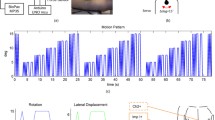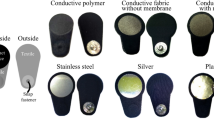Abstract
This study compared the performance of surface electromyographic (sEMG) sensors for different detection conditions affecting the electro-mechanical stability between the sensor and its contact with the skin. These comparisons were made to gain a better understanding of how specific characteristics of sensor design and use may alter the ability of sEMG sensors to detect signals with high fidelity under conditions of vigorous activity. The first part of the study investigated the effect of different detection surface contours and adhesive tapes on the ability of the sensor to remain in electrical contact with the skin. The second part of the study investigated the effects of different skin preparations and hydrophilic gels on the production of movement artifact resulting from sinusoidal and impact mechanical perturbations. Both parts of the study evaluated sensor performance under dry skin and wet skin (from perspiration) conditions. We found that contouring the detection surface and adding a more adhesive double-sided tape were effective in increasing the forces needed to disrupt the electrical contact between the electrodes and the skin for both dry skin and wet skin conditions. The mechanical perturbation tests demonstrated that hydrophilic gel applied to the detection surface of the sensor produced greater movement artifacts compared to sensors without gel, particularly when the sensors were tested under conditions in which perspiration was present on the skin. The use of a surfactant skin preparation did not influence the amount of movement artifacts that resulted from either the sinusoidal or impact perturbations. The importance of these findings is discussed in terms of their implications for improving sEMG signal fidelity through sensor design modifications and procedures for interfacing them with the skin.









Similar content being viewed by others
References
Aronson S, Geddes LA (1985) Electrode potential stability. IEEE Trans Biomed Eng 32:987–988
Basmajian J, De Luca CJ (1985) Muscles alive: their function revealed by electromyography, 5th edn. Williams and Wilkins, Baltimore, p 22
Blok J, van Asselt S, van Dijk J, Stegeman D (1997) On an optimal pasteless electrode to skin interface in surface EMG. In: Hermens HJ, Freriks B (eds) SENIAM 5: the state of the art on sensors and sensor placement procedures for surface electromyography: a proposal for sensor placement procedures. Roessingh Research and Development, Enschede, pp 71–76
De Luca CJ (1997) The use of surface electromyography in biomechanics. J Appl Biomech 13:135–163
De Luca C, Le Fever R, Stulen F (1979) Pasteless electrode for clinical use. Med Biol Eng Comput 17:387–390
de Talhouet H, Webster JG (1996) The origin of skin-stretch-caused motion artifacts under electrodes. Physiol Meas 17:81–93
DeVries KL, Borgmeier PR (2003) Testing of Adhesives. In: Pizzi A, Mittal KL (eds) Handbook of Adhesive Technology, Marcell Dekker, New York, pp. 223–253.
Fernandez M, Pallas-Areny R (2000) Ag–AgCl electrode noise in high-resolution ECG measurements. Biomed Instrum Technol 34:125–130
Gatzke RD (1974) The electrode: a measurement system viewpoint. In: Miller HA, Harrison DC (eds) Biomedical electrode technology. Academic, New York, pp 99–116
Geddes LA, Baker LE (1989) Principles of applied biomedical instrumentation, Chap. 9: electrodes. Wiley, New York, pp 315–452
Gondran C, Siebert E, Yacoub S, Novakov E (1996) Noise of surface bio-potential electrodes based on NASICON ceramic and Ag–AgCl. Med Biol Eng Comput 34:460–466
Hagemann B, Luhede G, Luczak H (1985) Improved “active” electrodes for recording bioelectric signals in work physiology. Eur J Appl Physiol Occup Physiol 54:95–98
Huigen E, Peper A, Grimbergen CA (2002) Investigation into the origin of the noise of surface electrodes. Med Biol Eng Comput 40:332–338
Inman VT (1953) The pattern of muscular activity in the lower extremity during walking. Calif Univ Techn Rep Ser III 25, pp 1–41
Kumar S (1996) Electromyography in ergonomics, In: Kumar S, Mital A (eds) Electromyography in ergonomics. Taylor & Francis, Bristol, pp 1–50
Merletti R, Hermens H (2004) Detection and conditioning of the surface EMG signal. In: Merletti R, Parker P (eds) Electromyography: physiology, engineering, and noninvasive applications. Wiley, New York, pp 107–132
Odman S, Oberg PA (1982) Movement-induced potentials in surface electrodes. Med Biol Eng Comput 20:159–166
Piper H (1907) Uber den willkurlichen muskeltetanus. Pflugers Arch Ges Physiol Mensch Tiere 119:301-338.
Roman J, Lamb L (1962) Electrocardiography in flight. Aerosp Med 33:527–544
Tassinary LG, Green TR, Cacioppo JT, Edelberg R (1990) Issues in biometrics: offset potentials and the electrical stability of Ag/AgCl electrodes. Psychophysiology 27:236–242
Tam HW, Webster JG (1977) Minimizing electrode motion artifact by skin abrasion. IEEE Trans Biomed Eng 24(2):134-139
Turker KS (1993) Electromyography: some methodological problems and issues. Phys Ther 73:698–710
Zipp P, Hennemann K, Grunwald R, Rohmert W (1980) Bioelectrode jellies for long-term monitoring. Eur J Appl Physiol Occup Physiol 45:131–145
Acknowledgments
The project was funded in part by SBIR awards from NASA (Contract # NAS 9-98035). We appreciate the assistance of Mr. Per Bergman in writing the data analysis software for the study and providing helpful suggestions during the planning stages of the research design and the preparation of this manuscript.
Author information
Authors and Affiliations
Corresponding author
Rights and permissions
About this article
Cite this article
Roy, S.H., De Luca, G., Cheng, M.S. et al. Electro-mechanical stability of surface EMG sensors. Med Bio Eng Comput 45, 447–457 (2007). https://doi.org/10.1007/s11517-007-0168-z
Received:
Accepted:
Published:
Issue Date:
DOI: https://doi.org/10.1007/s11517-007-0168-z




